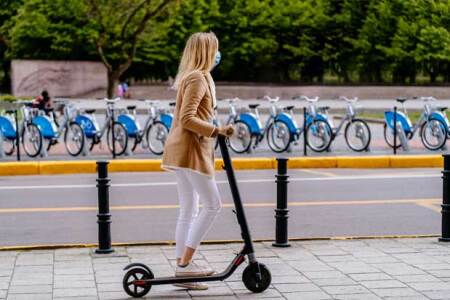Urban developers have become increasingly interested in building places with little or no dedicated parking spots. Then the COVID-19 pandemic hit, raising questions about the safety of public transit and changes to funding and service.
Although including less car parking creates cost savings for developers, encourages sustainable alternatives to driving, and aligns with other trends—such as low car ownership among millennials—it means that tenants need nearby parking options or other ways to get around, such as public transportation.
Now, despite growing evidence that public transportation is relatively low-risk, fears about transit’s safety persist. As transit systems face the financial repercussions of the pandemic, many will continue to reduce service. Both service cuts and discomfort with taking public transportation have driven people to alternatives, contributing to booms in both bicycle and used-car sales.
Against this backdrop, real estate professionals are wondering what today’s transit anxiety will mean for their properties going forward—especially those without parking on site. Even properties located near transit may be difficult to access for those who do not feel comfortable taking transit and who have limited parking options nearby.
However, with micromobility options continuing to proliferate in many cities, people do have other choices. Scooters and e-bikes provide a socially distanced, outdoor transportation option that expands multimodal access to properties and shifts people away from unnecessary car trips. In fact, 36 percent of scooter trips replace a car trip.
For relatively short trips that are just out of walking distance, scooters can help people reach destinations without the hassle of car parking. For longer trips, including commutes, e-bikes further expand the radius of where people can travel without relying on a car. As retail, apartment, and office spaces think about how tenants will choose to reach these properties during and after the pandemic, micromobility can play a role in keeping locations accessible without relying on parking.
“Five years ago, if you asked a developer in Santa Monica how much parking would they build if the requirements were reduced by half, they would still build more than the requirement. Today, developers are very open to building less parking,” says Carter Rubin, transportation technical strategist with the Bloomberg Philanthropies American Cities Climate Challenge, in Small Vehicles, Big Impact: Micromobility’s Value for Cities and Real Estate. “There are a number of no-parking buildings going up, or buildings with a lot less parking. It’s a very uncertain time, but the abundance of mobility choices has shown developers that they don’t need to provide two spaces per unit.”
Moreover, micromobility is one piece of the puzzle in building healthier, more sustainable cities—a goal shared among real estate and land use professionals, city officials, and residents. Even after the pandemic is over, climate change and air quality issues will remain major challenges. Less polluted urban environments make cities more attractive for development and boost the desirability of existing properties—one of the many ways that micromobility can contribute to a green pandemic recovery while creating value for real estate.
“There is an increased demand and interest in micromobility due to COVID-19 as people shift towards modes that enable social distancing and away from transit. On the flip side, we’re seeing people looking to car ownership with an increased demand for used cars,” says Amanda Howell, researcher with the Urbanism Next Center at the University of Oregon in Portland. “To the extent the real estate industry is willing to look ahead with cities, they can’t lose sight of their pre-pandemic priorities, including reducing carbon emissions. The pandemic will not go on forever. At the end of it, we need to be better off than we were before it.”
Small Vehicles, Big Impact: Micromobility’s Value for Cities and Real Estate highlights how the real estate industry can “look ahead with cities” and harness the potential of micromobility. Primarily, real estate professionals can support dockless, shared, electric micromobility options—such as scooters and e-bikes—by providing infrastructure like on-site charging stations or scooter dropoff zones in spaces formerly used for parking spots.
With investments in scooter and e-bike infrastructure, the real estate industry helps make micromobility a more reliable option, complementing cities’ critical roles in bolstering safety and connectivity with networks of protected bike lanes. This infrastructure also provides amenity value, a first-mile/last-mile solution for commuters, and potential benefits—such as reduced parking requirements for developers—when negotiating with cities.
Moreover, city policies can help ensure that micromobility is accessible to and beneficial for everyone by requiring non-smartphone options to unlock scooters, subsidies for low-income riders, and vehicle deployment in each neighborhood, among other policies.
Of course, real estate professionals will face a different set of considerations in each city. Cold and snowy winters may make micromobility less attractive to users in some cities, and city regulations may affect the availability of micromobility options. In cities with especially high land costs, shifting away from building expensive parking spots and toward supporting micromobility use may be particularly compelling.
Despite differences in city contexts, micromobility is increasingly part of a robust transportation ecosystem, and its role will continue to be important as people remain wary of public transit for the remainder of the pandemic. A green recovery will require reducing use of single-occupancy vehicles while ensuring that people feel safe getting to work, home, and other destinations. For properties that already have little to no parking—and for developers who remain curious about minimizing their parking—installing micromobility-supportive infrastructure can be a part of the solution and a smart investment.
“We have so much work to do, and we need to be bold,” says Laura Miller Brooks, senior transportation and infrastructure associate at the Washington, D.C.,-based Federal City Council. “Micromobility and bike networks are low-cost, high-impact tools for an equitable recovery from the lasting effects of COVID. We can’t wait.”
Learn more in Small Vehicles, Big Impact: Micromobility’s Value for Cities and Real Estate.
DIANA SCHODER is a senior associate with the Building Healthy Places Initiative.





